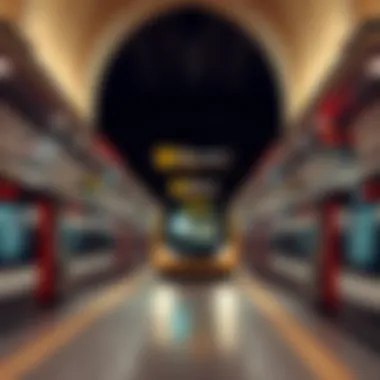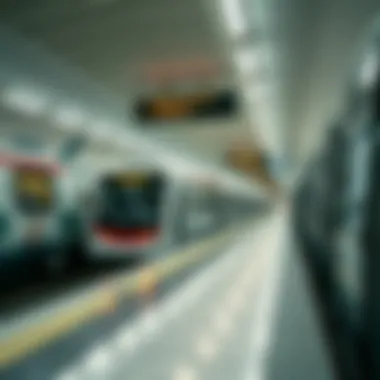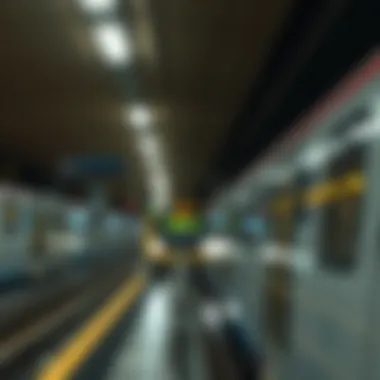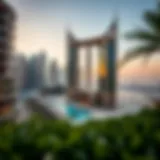Operating Hours of Dubai's Metro System Explained


Intro
Navigating a city as bustling as Dubai takes some planning, especially when relying on public transport. One of the most efficient ways to get around is undoubtedly Dubai Metro. This extensive rail network plays a pivotal role in connecting not just various parts of Dubai, but also aids in easing the traffic congestion that often plagues the city. Understanding the metro's operating hours is essential for both residents and tourists alike. This knowledge ensures travelers can effectively plan their commutes without any hiccups.
While the metro offers a convenient option to traverse the city, it’s not without its quirks. The schedule varies on weekdays versus weekends and can change due to public holidays or special events, offering a unique nuance that requires some attention. By laying out the details of operating hours, we can facilitate a smoother travel experience, maximizing the benefits of this commendable transport service. Effective planning means knowing when the trains run and being aware of possible variations in the schedule. Thus, potential users can make the most of their time in this vibrant metropolis.
Let's delve into the operating hours of Dubai Metro, explore its effects on daily life, and examine how it fits into the broader context of the transport system in Dubai. It’s not just about the times the metro operates—it’s about understanding the implications on connectivity and convenience for everyone utilizing this vital network.
Understanding Dubai Metro
The Dubai Metro system stands as a symbol of modern urban transport, making it an essential aspect of the city's infrastructure. To grasp the significance of its operating hours, one must first understand the core elements that shape this vital transit option. The metro not only provides a framework for commuting but also reflects the city's rapid urbanization and commitment to sustainable transit solutions.
Overview of the Metro System
The Dubai Metro, with its distinctive red and green lines, is a marvel of engineering and planning.
- Length and Coverage: Currently, the system spans over 75 kilometers, connecting major landmarks, shopping centers, and business districts. The network is designed to serve not only citizens but also countless tourists flocking to this cosmopolitan hub.
- Type of Trains: Featuring driverless trains, the metro operates with cutting-edge technology, enhancing reliability and efficiency. The automated system reduces wait times, ensuring that travelers can reach their destinations with minimal hassle.
The operating hours of the metro are meticulously planned to align with the daily routines of both residents and visitors. For instance, knowing the exact opening and closing times can mean the difference between a smooth commute and getting stranded. Thus, finding the right time to travel is crucial to making the most of what Dubai has to offer.
Importance in Urban Planning
In the broader context of urban planning, the Dubai Metro is not merely a mode of transport; it is a keystone in achieving the emirate's vision for sustainable, integrated mobility.
- Reducing Traffic Congestion: By providing an efficient alternative to road travel, the metro helps alleviate congestion on Dubai's busy highways, lessening commute times for everyone.
- Environmental Benefits: Public transport systems, like the metro, have a significantly lower carbon footprint compared to private vehicles, thus contributing to cleaner air and a healthier environment.
- Economic Growth: As metro stations often emerge near commercial hubs, they serve to stimulate economic activity. The convenience offered by the metro can bolster property values and encourage investments in surrounding areas.
The interplay between the metro's operating hours and its impact on various sectors emphasizes the need for comprehensive planning to meet the demands of a growing city. As more people turn to public transport, understanding its operational parameters becomes essential for investors, home buyers, and property managers alike.
Regular Operating Hours
Understanding the regular operating hours of Dubai's Metro system is crucial, not only for residents but also for visitors. The schedules play a vital role in the everyday movement of people throughout the city, allowing seamless connectivity across various neighborhoods and districts. Comprehending these hours helps users better plan their journeys, minimizing frustration and maximizing efficiency.
Opening Times During Weekdays
On weekdays, the Dubai Metro operates from 5:00 AM until midnight. This window allows commuters ample opportunity to use the metro for both work and leisure activities. The service typically sees a heavier flow of passengers in the early morning as residents head to their workplaces. As such, the early hours might be quite congested, especially between 7:00 AM and 9:00 AM.
Travelers should also note that during the weekdays, the frequency of trains is generally higher during peak hours. This translates to shorter waiting times and faster connections for those who rely on this transport option.
Moreover, the exact schedules may vary slightly depending on the specific metro line, but overall, the weekday structure remains consistent. Knowledge of these operating hours can be particularly beneficial for property managers and investors, as it impacts the accessibility of locations near metro stations.
Weekend and Holiday Hours
When it comes to weekends, the metro works a bit differently. On Fridays and Saturdays, the operational hours are from 10:00 AM to midnight. This change is tailored to accommodate the leisure activities of residents and tourists, offering a later opening time which can be more convenient for those looking to enjoy the city's attractions.
Public holidays also affect the metro system’s schedule. Typically, during major public holidays, the operating hours might extend, which is a welcome change for people who are out celebrating or looking to travel. Passengers should keep an eye on announcements during the festive seasons, as these adjustments can enhance travel options significantly.


In summary, regular operating hours are a fundamental aspect of navigating the Dubai Metro. Understanding the weekday and weekend specifications helps users to plan effectively, enhances their travel experience, and supports the broader shift towards efficient urban transport.
Variations in Schedule
In this section, we delve into how the operating hours of Dubai's Metro system can shift depending on various external factors. Understanding these variations is essential for anyone navigating the metro, be it for daily commutes, weekend outings, or special events. Flexibility in operating hours not only caters to the fluid nature of urban life in Dubai but also enhances user accessibility and convenience.
Public Holidays and Event Days
Dubai is known for its vibrant culture and numerous public holidays that often see a surge of local and tourist activity. During public holidays, such as Eid, National Day, and other significant occasions, the metro adjusts its schedule. Here are some key points to consider:
- Extended Hours: On major public holidays, the metro might open earlier and close later. This is ideal for individuals heading to celebrations, shopping festivals, or family gatherings.
- Special Services: Sometimes, special services might be put in place to accommodate larger crowds.
- Increased Frequency: To manage commuter demand during peak times on holidays, trains often operate with increased frequency, ensuring that the system remains efficient even on bustling days.
For example, during the Eid holidays, the metro stays open longer, giving residents the chance to explore festive markets and events without the worry of rush hour restrictions.
On important holidays, Dubai Metro adapts its hours to meet the high passenger demand and offers additional services for travelers.
Impact of Ramadan
Ramadan, the holy month of fasting for Muslims, presents unique scheduling challenges for public transportation, and Dubai Metro is no exception. Operating hours during Ramadan can vary widely, reflecting the changes in daily routines observed by many residents. Here are some critical insights:
- Altered Opening and Closing Times: Typically, the metro does not operate on its usual schedule during Ramadan. For instance, trains may begin their service later in the morning to accommodate the needs of those observing fast, and then they run later into the night, allowing for travel after iftar.
- Evening Peak Hours: The demand for metro services can peak post-iftar as people flock to malls, restaurants, and entertainment venues. This leads to more crowded trains, especially during weekends throughout Ramadan.
- Useful for Social Gatherings: The adjusted hours are especially favorable for social gatherings post-fasting hours, facilitating the connectivity of families and friends during this festive time.
In summary, being aware of the variations in the metro's schedule due to public holidays and Ramadan is paramount for both residents and visitors. This understanding can lead to more streamlined planning of journeys within the city, allowing individuals to make the most of the vibrant atmosphere that these occasions bring.
Factors Influencing Operating Hours
The operating hours of the Dubai Metro system are shaped by various factors that reflect both user needs and operational necessities. Understanding these factors is crucial not only for frequent riders but also for potential investors and stakeholders in the city's transportation sector. Operating hours need to adapt to the ever-changing dynamics of urban transportation, responding to shifts in passenger demand, as well as ensuring safety and maintenance protocols are seamlessly integrated.
Passenger Demand Fluctuations
Every city has its rhythm, and for Dubai's Metro, this rhythm is determined largely by passenger demand. The transport network experiences peak and lull periods, often correlated with work hours, school schedules, and seasonal events. For instance, during the weekday rush hours, the trains are packed tighter than sardines, whereas, during late-night hours, it’s a starkly different scene, perhaps just a handful of passengers. This ebb and flow impact how long the trains operate, as service is extended to accommodate the morning commuters and cut short late at night when ridership dwindles.
Consider these fluctuations in ridership:
- Weekday Peaks: The typical morning and evening rush periods.
- Leisure Traffic: Weekends and holidays see a rise in family outings and tourists, necessitating adjusted hours to ensure a steady flow.
- Special Events: Major events can create a surge in demand. For example, during events like the Dubai Shopping Festival, the Metro operates longer to serve the influx of shoppers.
By analyzing ridership data, officials can optimize service—keeping the trains running when passengers need them most while conserving resources during quieter times.
Safety Protocols and Maintenance
Safety is undeniably a pillar of any public transport system. The Dubai Metro prioritizes passenger safety through regular maintenance checks and compliance with stringent safety protocols. These factors invariably influence operating hours as well. Maintenance often requires temporary closures or reduced service hours to ensure all systems are functioning smoothly and safely.
Here are key considerations regarding safety protocols and maintenance:
- Scheduled Maintenance: Regular inspections are a must, leading to planned service suspensions usually during off-peak hours or early Sundays. Riders are often informed ahead of time to avoid inconvenience.
- Emergency Protocols: If unforeseen mechanical issues arise, the Metro may need to halt service, necessitating updates and real-time notifications to ensure passengers are well-informed.
- Safety Drills: Regular training sessions for staff also result in modified hours to enhance preparedness and safety assurance.
Through careful planning and execution of maintenance operations, the Metro system not just enhances passenger safety but also boosts the confidence of investors seeking a reliable transport infrastructure in Dubai. Such measures contribute not only to the efficiency of the metro system but also to its sustainability, making it a vital cog within the wider urban transport framework.


"Transport is the backbone of our urban life, and ensuring its smooth operation is a commitment we hold paramount."
As Dubai continues to grow and evolve, the adaptability of the Metro's operating hours to passenger demand and safety requirements will remain a defining element of its operational strategy.
Benefits of Using Metro
The Dubai Metro system presents numerous advantages that extend beyond mere transportation. This section aims to illuminate why utilizing the metro can benefit both residents and visitors, especially in a metropolis as sprawling as Dubai. From reducing travel costs to lessening environmental impacts, the metro stands as a modern solution for urban mobility.
Cost-Effectiveness
When considering the cost of commuting in Dubai, the metro offers a wallet-friendly alternative to taxis and private cars. For instance, a single journey fare may range from just AED 3 to AED 8, depending on the distance traveled. Comparatively, taxis can run much higher, especially during peak hours. By opting for the metro, users not only save money but also benefit from a fixed pricing structure—a welcome change for budget-conscious travelers.
Furthermore, for frequent travelers, the NOL card presents a practical solution. Users can recharge this card and avail themselves of discounts on multiple trips, further enhancing its cost-efficiency. With a monthly pass option also available, regular commuters can enjoy even greater savings, making it an economical choice for those who rely on public transportation in their daily lives.
In addition to fares, the metro’s efficiency can save users precious time. The absence of traffic congestion along its routes minimizes delays, allowing individuals to arrive at their destinations on schedule, which can positively impact work productivity and personal commitments. Thus, one can conclude that the economic appeal of the metro makes it a pragmatic alternative in a city driven by activity and growth.
Environmental Impact
The environmental implications of transport choices cannot be overstated. The Dubai Metro operates on a fully electric system, contributing to lower greenhouse gas emissions in comparison to fossil fuel-powered vehicles. By reducing the number of cars on the road, the metro plays a crucial role in improving air quality, which is vital for public health and the preservation of the city's natural beauty.
Key Highlights:
- Reduced Carbon Footprint: Each journey taken via the metro effectively cuts down the emissions typically generated by cars.
- Energy Efficiency: Electric trains are designed for efficiency, consuming far less energy per passenger than individual automobiles.
- Urban Development: The metro supports sustainable city growth, encouraging high-density developments around stations, which can further reduce reliance on cars.
"Using public transport like the metro minimizes individual carbon footprints and fosters a greener urban space."
In essence, the environmental impact of utilizing the metro transcends mere convenience; it reflects a commitment to sustainable living. For investors and property managers, this aspect of public transportation can be a deciding factor in making informed choices that align with Dubai's vision for a more sustainable future.
Thus, knowing these benefits—both financial and ecological—can influence how both residents and visitors approach their travel plans in Dubai, ultimately leading to a more sustainable and efficient means of navigation within this vibrant city.
Practical Considerations for Users
Understanding the practicalities surrounding the Dubai Metro system can significantly enhance the travel experience for both residents and visitors. This section aims to provide insights into the different factors to consider when planning a journey. Knowing when to travel, how to navigate, and understanding the available facilities can make all the difference in ensuring a smooth commute.
Planning Your Journey
When planning a journey using the Dubai Metro, timing and awareness of the route are paramount. One must consider not just the departure and arrival times, but also how delays or high traffic might affect travel. Here are some critical points to bear in mind:
- Operating Hours: Familiarize yourself with the operating hours, especially if traveling late at night or early morning. The trains do not run all night, so having a timetable handy can prevent unnecessary hassle.
- Route Mapping: Prior to your trip, it’s advisable to map out your route using the Metro's official app or a navigation platform. This app gives real-time updates which can save time and stress.
- Peak Times: Try to avoid traveling during rush hours, typically from 7:00 AM to 9:00 AM and from 5:00 PM to 7:00 PM on weekdays. The trains can be quite packed, and this can affect your comfort.
- Purchase Your Ticket in Advance: Tickets can be bought at automated machines or the ticket counters at any station. Opting for a Nol Card can simplify transactions and often provides discounts.
Engaging in pre-planning can mean the difference between a seamless experience and a frustrating one. Investing just a few minutes in preparation allows travelers to enjoy the ride without the worry of unforeseen complications.
Navigating the Metro System
Navigating the Dubai Metro is generally straightforward, thanks to its user-friendly design and well-defined signage. But there are nuances that can ease your journey. Consider the following:


- Color-Coded Lines: The Metro has distinct colored lines (Red and Green) that traverse major parts of the city. Knowing which colored line to take can streamline your journey significantly.
- Stations Overview: Get familiar with key stations. Key hubs such as Union Station, Burj Khalifa/Dubai Mall, and Dubai Marina are interconnected and offer a host of services, including shopping and dining.
- Accessibility: The Dubai Metro system is designed to be accessible to individuals with disabilities. Ensure to read about the provisions available for those needing assistance.
- Emergency Protocols: Always make yourself aware of emergency procedures. Whether it’s knowing where to go during an evacuation or how to contact a metro employee for help, having this info can be crucial.
As you step into the Metro, let the journey be a vital aspect of your Dubai experience. The transit system not only connects various parts of the city, but also showcases the forward-thinking infrastructure that Dubai is renowned for.
Future of Dubai Metro Operating Hours
Understanding the future trajectory of Dubai Metro operating hours is crucial, especially for those with investments in the real estate or transport sectors. As Dubai continues to evolve, it is essential to grasp how forthcoming expansions and advancements in technology may influence operational policies. The integration of emerging technologies and strategic planning can not only improve user experience but also cater to the increasing demands of a growing population.
Potential Expansion of Services
One significant aspect to consider is the potential expansion of services offered by the Dubai Metro. Given the rapid growth in both tourism and residential demands, there's a tangible push for more flexible and accessible transport options. This is not just about adding more trains or routes—it's about rethinking service delivery. For instance:
- Extended operating hours, especially on weekends, could cater to night owls and increase leisure travel.
- New routes could connect underserved areas, tapping into neighborhoods that remain distant from current transit lines.
- Integration with other transportation modes, such as taxis or e-scooters, would enhance multimodal transport hubs, making transfers smoother.
Thus, the anticipated expansion isn’t merely about covering more ground; it’s about building a mosaic of connectivity that respects residents' and tourists' diverse needs.
Impact of Technological Advancements
Technological advancements will undeniably play a pivotal role in the evolution of the Dubai Metro's operational hours. Innovations promise to enhance reliability and user convenience, making journeys not just faster but also more enjoyable. Key aspects may include:
- Smart scheduling powered by data analytics, predicting peak times and adjusting train frequencies accordingly. Imagine trains arriving precisely when you need them without long waits.
- Mobile applications that provide real-time updates about service changes would make planning simple. A simple ping on your phone could inform users of any alterations in service, sparing them the hassle of unexpected delays.
- The implementation of automated systems could streamline maintenance and reduce downtime, ensuring that essential components are functioning optimally.
"The future holds a promise of efficiency that could reshape urban commuting in ways we have yet to fully envision."
Ultimately, the amalgamation of these advancements paints a promising picture. Through innovation, the Metro system can achieve greater efficiency and adaptability, ensuring it meets the demands of both current users and future passengers migrating toward the city's dynamic changes.
As with any infrastructure program, understanding how these developments will unfold helps investors, homebuyers, and property managers to make informed decisions. Stay attuned to these shifts, as they will not only redefine commuting in Dubai but may also impact property values and economic activity within key neighborhoods.
For more insights on urban planning and transport systems, you might explore additional resources on Wikipedia or Britannica.
Culmination
The operating hours of the Dubai Metro system are not merely a set of times; they are a fundamental aspect of the urban landscape that shapes transportation, commerce, and the daily rhythm of life in Dubai. Understanding the metro's schedule is crucial for both residents and visitors. This knowledge empowers users to plan their journeys effectively, minimizing wait times and maximizing convenience.
Summarizing Key Points
The metro operates on a schedule that varies during weekdays and weekends, ensuring accessibility for a diverse range of commuters. Key points to remember include:
- Weekday Operations: The metro typically opens at 5 AM on weekdays, closing at midnight. This timeframe accommodates early morning commuters and late-night travelers alike.
- Weekend Adjustments: On Fridays and Saturdays, the metro shifts to a slightly later opening time of 10 AM, adjusting to local customs and practices.
- Holiday Variations: Special operating hours are enforced during public holidays and major events, which are crucial for managing increased passenger volumes.
Furthermore, factors like passenger demand and maintenance routines can occasionally alter the expected schedule.
Encouraging Informed Travel
For those looking to navigate Dubai's transportation network, it’s vital to stay informed about the metro's operating schedule. A few practical tips include:
- Checking Official Sources: Websites like the Roads and Transport Authority (RTA) often provide updated schedules and changes in real-time, making it easier to plan.
- Using Metro Apps: Various mobile applications detail train arrivals, route planning, and operational adjustments, offering a streamlined travel experience.
- Planning for Peak Times: Recognizing when the metro is busiest can help in avoiding peak travel times, thus enhancing one’s experience.
"Stay ahead of the game by keeping the metro's schedule handy and planning accordingly!"
By understanding these aspects of the Dubai Metro, passengers can make informed travel decisions that align with their schedules and preferences, thereby maximizing the utility of this vital public transport system. For residents and visitors, the metro is more than just a means of transportation; it’s a gateway to exploring everything that makes Dubai vibrant.
For more insights into the Dubai Metro system, you can visit Dubai's RTA or check Wikipedia for detailed historical insights.















